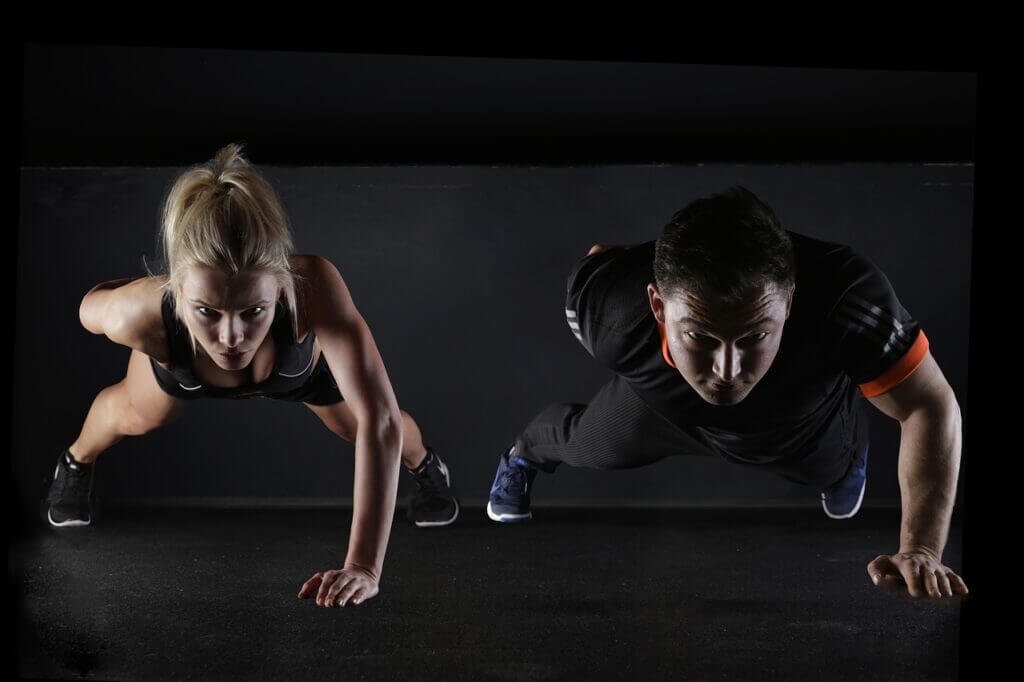Congratulations on reaching the prime of your life! As you enter your 50s and beyond, it’s essential to prioritize your health and well-being. This article will provide you with an array of effective and enjoyable workouts tailored specifically for individuals aged 50 and over. Whether you’re a fitness enthusiast looking to maintain your physical prowess or someone who wants to kickstart their journey towards a healthier lifestyle, these exercises will help you stay active and vibrant. From low-impact exercises to strength training routines, this guide has got you covered. Get ready to embrace the benefits of exercise and start feeling fabulous at 50 and beyond!
Benefits of Regular Exercise for People Over 50
Regular exercise has numerous benefits for people over 50. Not only does it contribute to overall physical well-being, but it also has positive effects on mental health and cognitive function. Here are some of the key benefits you can expect when incorporating regular exercise into your routine.
Improved cardiovascular health
Engaging in regular exercise can significantly improve your cardiovascular health. Activities like walking, cycling, swimming, dancing, and water aerobics help strengthen your heart and lungs, boosting their efficiency in delivering oxygen and nutrients to your body. This, in turn, reduces the risk of heart disease, lowers blood pressure, and improves circulation.
Increased muscle strength
As we age, muscle strength tends to decline. However, with regular exercise, you can maintain and even increase your muscle strength. Strength training exercises, such as bodyweight exercises, resistance band workouts, dumbbell exercises, machine or free weight exercises, and functional training, target different muscle groups and promote muscle growth. Strong muscles contribute to better posture, balance, and overall physical performance.
Enhanced flexibility and mobility
Maintaining good flexibility and mobility is essential for performing daily activities and preventing injuries. Engaging in flexibility exercises, such as stretching, yoga, tai chi, pilates, and balance exercises, can help improve your range of motion and keep your joints and muscles supple. These exercises also increase your body’s ability to adapt to different movements, reducing the risk of strains, sprains, and falls.
Improved bone density
Osteoporosis, a condition characterized by low bone density and increased vulnerability to fractures, is common in older adults. Regular exercise, especially weight-bearing exercises like walking and strength training, helps strengthen bones and increase bone density. By stimulating bone growth, exercise can reduce the risk of osteoporosis and improve overall bone health.
Weight management and metabolism
Maintaining a healthy weight becomes more challenging as we age due to changes in metabolism. Regular exercise, along with a balanced diet, is crucial for weight management. It helps burn calories, build muscle mass, and boost metabolism. By incorporating both cardiovascular exercises and strength training into your routine, you can effectively manage your weight and achieve a healthy body composition.
Reduced risk of chronic diseases
Engaging in regular exercise has been shown to significantly lower the risk of chronic diseases commonly associated with aging, such as heart disease, diabetes, and certain types of cancer. By maintaining a healthy weight, controlling blood pressure and cholesterol levels, and enhancing cardiovascular health, exercise acts as a preventive measure against these diseases. It also positively impacts blood sugar control, reducing the risk of developing diabetes.
Enhanced mental health and cognitive function
Exercise not only benefits your physical health but also has a profound impact on your mental well-being and cognitive function. Research has shown that regular exercise reduces the risk of developing mental health conditions like depression and anxiety. It also improves mood, promotes relaxation, and enhances overall cognitive function, including memory and attention. Engaging in physical activity releases endorphins, which are often referred to as “feel-good” hormones, contributing to a sense of well-being.
Considerations Before Starting a Workout Routine
Before you embark on a workout routine, it is important to consider a few factors to ensure your safety and maximize the effectiveness of your exercise regimen. Here are some key considerations:
Consult with a healthcare professional
Before starting any exercise program, it is crucial to consult with a healthcare professional, especially if you have any pre-existing medical conditions or concerns. A healthcare professional can assess your overall health and provide you with guidance specific to your needs.
Assess your current fitness level
Understanding your current fitness level is essential to determine the appropriate intensity and type of exercises for your workout routine. Consider factors such as your strength, flexibility, cardiovascular endurance, and balance. This self-assessment will help you establish a baseline and set realistic goals for your fitness journey.
Set realistic goals
Setting realistic and achievable goals is essential to stay motivated and track your progress. Whether you aim to improve your cardiovascular endurance, increase muscle strength, lose weight, or enhance flexibility, having specific and measurable goals will help you stay focused and motivated.
Choose suitable workout types
Choosing workout types that align with your goals and preferences is crucial for long-term commitment and enjoyment. Consider activities that you enjoy and that suit your current fitness level. If you prefer low-impact exercises, focus on activities such as walking, swimming, or water aerobics. If you enjoy strength training, explore options like bodyweight exercises, resistance band workouts, or dumbbell exercises.
Listen to your body and adapt
One of the most important considerations when starting a workout routine is to listen to your body and adapt accordingly. Pay attention to any discomfort, pain, or fatigue during your workouts. It’s important to push yourself, but not to the point of risking injury. If you experience persistent pain or discomfort, it’s advisable to consult with a healthcare professional.

Cardiovascular Exercises
Walking
Walking is a simple, accessible, and effective cardiovascular exercise that can be easily incorporated into your daily routine. Whether it’s a brisk walk around your neighborhood, walking on a treadmill, or hiking in nature, this low-impact exercise strengthens your heart, improves circulation, and boosts your overall cardiovascular health.
Cycling
Cycling, whether outdoors or on a stationary bike, is another excellent cardiovascular exercise for people over 50. It provides an efficient workout for your heart and lungs while being gentle on the joints. Cycling can be done at your own pace and intensity, making it suitable for beginners as well as those looking for a more challenging workout.
Swimming
Swimming is a low-impact, full-body workout that offers numerous benefits for people of all ages. It engages multiple muscle groups, improves cardiovascular endurance, and enhances flexibility. Additionally, swimming is easy on the joints, making it an excellent exercise option for individuals with joint pain or arthritis.
Dancing
Dancing is a fun and social way to get your heart rate up and boost your cardiovascular health. Whether it’s ballroom dancing, Zumba, or an aerobics dance class, dancing helps improve endurance, coordination, balance, and flexibility. It also provides a mental and emotional boost by reducing stress and increasing social interaction.
Water aerobics
Water aerobics is a low-impact exercise that takes place in a swimming pool. It combines cardiovascular exercises with resistance training, making it an excellent workout for people over 50. The water provides buoyancy, reducing stress on the joints, while the resistance of the water strengthens muscles and improves cardiovascular fitness.
Strength Training Exercises
Bodyweight exercises
Bodyweight exercises are exercises that use your body weight as resistance. These exercises include push-ups, squats, lunges, planks, and sit-ups, among others. Bodyweight exercises help build strength, improve muscle tone, and can be easily modified to suit different fitness levels.
Resistance band workouts
Resistance bands are elastic bands that provide resistance when stretched. They come in various levels of resistance, making them suitable for beginners as well as more advanced individuals. Resistance band workouts target specific muscle groups and can be done at home or anywhere with minimal equipment.
Dumbbell exercises
Dumbbell exercises are a popular form of strength training that uses handheld weights. They enable you to target specific muscle groups and increase resistance as you progress. Dumbbell exercises can be done with a variety of weights and can be adjusted to suit your fitness level.
Machine or free weight exercises
If you have access to a gym, you can incorporate machine or free weight exercises into your strength training routine. Machines provide a controlled range of motion and target specific muscle groups, while free weights require more stabilization and engage additional muscles for balance. With proper guidance and technique, machine or free weight exercises can effectively build muscle strength.
Functional training
Functional training focuses on exercises that mimic movements and activities performed in daily life. It improves strength, endurance, balance, and coordination for everyday tasks. Functional training can include exercises such as squats, lunges, lifting weights, and balance exercises on unstable surfaces.

Flexibility and Balance Exercises
Stretching exercises
Stretching exercises help improve flexibility, enhance range of motion, and prevent muscle imbalances. Static stretches, where you hold a stretch for a period of time, and dynamic stretches, which involve controlled movements, are both beneficial. Include stretches for all major muscle groups to maintain flexibility in your entire body.
Yoga
Yoga is a holistic exercise that combines physical poses, breathing techniques, and meditation. It promotes flexibility, strength, balance, and relaxation. Yoga offers numerous variations and can be adapted to suit different fitness levels and needs. You can choose from gentle styles like Hatha or restorative yoga, or more vigorous styles like Vinyasa or Ashtanga yoga.
Tai chi
Tai chi is a gentle martial art that involves slow, flowing movements and deep breathing. It enhances balance, flexibility, and body awareness. Tai chi is particularly beneficial for older adults as it helps reduce the risk of falls, improves posture, and promotes relaxation and mental well-being.
Pilates
Pilates is a low-impact exercise that focuses on core strength, flexibility, and body alignment. It involves controlled movements and breathing techniques that target deep core muscles. Pilates improves posture, stability, and overall body strength. It can be practiced on a mat or with specialized equipment like the reformer or stability ball.
Balance exercises
Balance exercises are essential for maintaining stability, preventing falls, and enhancing overall mobility. Simple exercises like standing on one leg, walking in a straight line heel-to-toe, or using a balance board or Bosu ball can challenge your balance and improve your proprioception. Regular practice of balance exercises can help improve stability and reduce the risk of injuries.
Tips for Safe and Effective Workouts
Engaging in safe and effective workouts is essential to maximize the benefits of exercise while minimizing the risk of injury. Here are some tips to keep in mind:
Warm up and cool down properly
Before starting any exercise, it’s important to warm up your muscles and prepare your body for physical activity. A warm-up should include light aerobic movements, such as marching in place or arm circles, followed by stretching exercises specific to the muscles you’ll be using during your workout. After your workout, cool down with gentle stretching to help reduce muscle soreness and promote recovery.
Start with low-impact exercises
If you’re new to exercise or have any joint or muscle concerns, start with low-impact exercises. These exercises are gentler on the joints and reduce the risk of injury. Gradually increase the intensity and impact of your workouts as you gain strength and endurance.
Gradually increase intensity and duration
It’s important to progress gradually in terms of intensity and duration of your workouts. Pushing yourself too hard or too quickly can lead to injury or burnout. Gradually increase the intensity, duration, or frequency of your exercises over time to ensure steady progress and avoid overexertion.
Use proper form and technique
Maintaining proper form and technique during exercises is crucial for safety and optimal results. Improper form can lead to injuries or strain on joints and muscles. If you’re unsure about the correct form, seek guidance from a qualified fitness professional or consider taking a beginner’s class to learn proper techniques.
Stay hydrated and fuel your body
Proper hydration is essential for optimal performance and recovery. Drink water before, during, and after your workouts to stay hydrated. Additionally, fuel your body with a balanced diet that includes a variety of nutrients to support your energy needs and help your body recover.
Include rest days and recovery
Rest and recovery are essential components of any exercise routine, especially as we age. Allow your body time to recover and repair between workouts. Rest days can help prevent overuse injuries and allow your muscles to rebuild and grow stronger. Listen to your body and adjust your exercise schedule accordingly.

Exercise Modifications for Specific Health Conditions
Exercise can be modified to accommodate specific health conditions to ensure safe and effective workouts. Here are some modifications for common health conditions:
Arthritis
For individuals with arthritis, low-impact exercises that are gentle on the joints are recommended. Walking, cycling, swimming, water aerobics, and exercises that focus on flexibility, such as yoga and tai chi, can help improve joint mobility and reduce pain.
Osteoporosis
For individuals with osteoporosis, exercises that help build bone density and improve balance are beneficial. Weight-bearing exercises like walking, jogging, dancing, and strength training exercises that target the major muscle groups can help maintain or improve bone density. It is important to consult with a healthcare professional and a qualified fitness professional to ensure proper form and safety.
Heart conditions
Individuals with heart conditions should consult with a healthcare professional before starting any exercise program. In some cases, exercises that involve low to moderate intensity, such as walking, cycling, or swimming, may be recommended. A healthcare professional can provide guidance on exercise recommendations based on the specific heart condition.
Diabetes
Exercise can have significant benefits for individuals with diabetes. Engaging in regular physical activity helps improve blood sugar control and insulin sensitivity. Both cardiovascular exercises and strength training can help maintain healthy blood sugar levels. It is important for individuals with diabetes to monitor their blood sugar levels before, during, and after exercise and potentially adjust medications or food intake accordingly.
Joint replacements
For individuals who have undergone joint replacement surgery, it is important to consult with a healthcare professional or physical therapist before starting any exercise program. Rehabilitation exercises specific to the replaced joint are typically recommended to aid in recovery and strengthen the surrounding muscles. Gradually transitioning to low-impact exercises, such as swimming or cycling, can also be beneficial.
Maintaining Motivation and Overcoming Challenges
Maintaining motivation and overcoming challenges that may arise during your fitness journey is crucial for long-term success. Here are some tips to help you stay motivated and overcome common challenges:
Find a workout buddy or join a group
Exercising with a friend or joining a group can provide social support and make workouts more enjoyable. Having someone to hold you accountable and share your exercise journey can greatly enhance motivation and make the experience more enjoyable.
Set specific goals and track progress
Setting specific and achievable goals helps maintain focus and motivation. Track your progress by keeping a workout journal or using smartphone apps to monitor your workouts, record achievements, and celebrate milestones along the way.
Mix up your workouts to avoid boredom
Doing the same exercises day after day can lead to boredom and eventually decrease motivation. Keep your workouts interesting by incorporating a variety of exercises and trying new activities. This not only helps prevent boredom but also challenges your body in different ways, leading to better overall results.
Celebrate achievements and reward yourself
Celebrate your achievements, no matter how small. Treat yourself to a new workout outfit, a massage, or another reward that motivates you. Acknowledging your hard work and progress can boost your confidence and keep you motivated to continue working towards your fitness goals.
Seek professional guidance if needed
If you’re unsure about the best approach to exercise or have specific health concerns, don’t hesitate to seek professional guidance. A certified personal trainer, fitness instructor, or healthcare professional can provide personalized advice and help customize an exercise program that suits your needs and abilities.

Conclusion
Regular exercise offers numerous benefits for people over 50, including improved cardiovascular health, increased muscle strength, enhanced flexibility and mobility, improved bone density, weight management, reduced risk of chronic diseases, and enhanced mental health and cognitive function. Before starting a workout routine, it is important to consult with a healthcare professional, assess your current fitness level, set realistic goals, choose suitable workout types, and listen to your body. Incorporating cardiovascular exercises, strength training exercises, flexibility and balance exercises, and following safety guidelines will help ensure safe and effective workouts. Exercise modifications can be made for specific health conditions, and staying motivated and overcoming challenges can be achieved by finding a workout buddy, setting goals, varying your workouts, celebrating achievements, and seeking professional guidance when needed. Embrace the benefits of regular exercise and enjoy a healthier and more active lifestyle well into your golden years.


